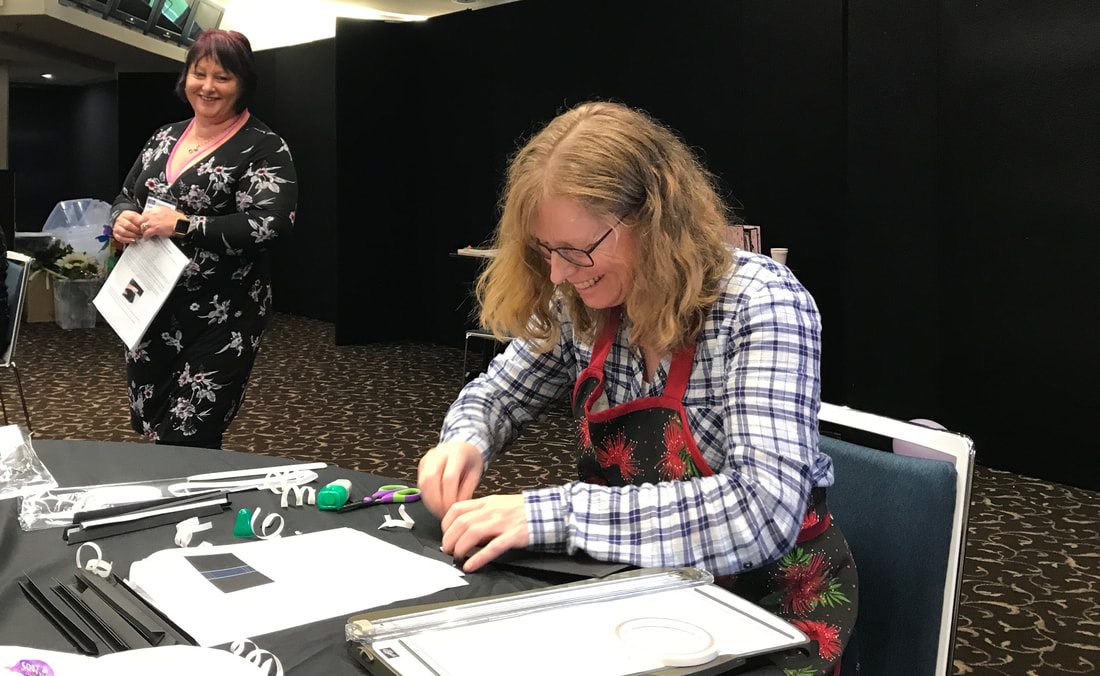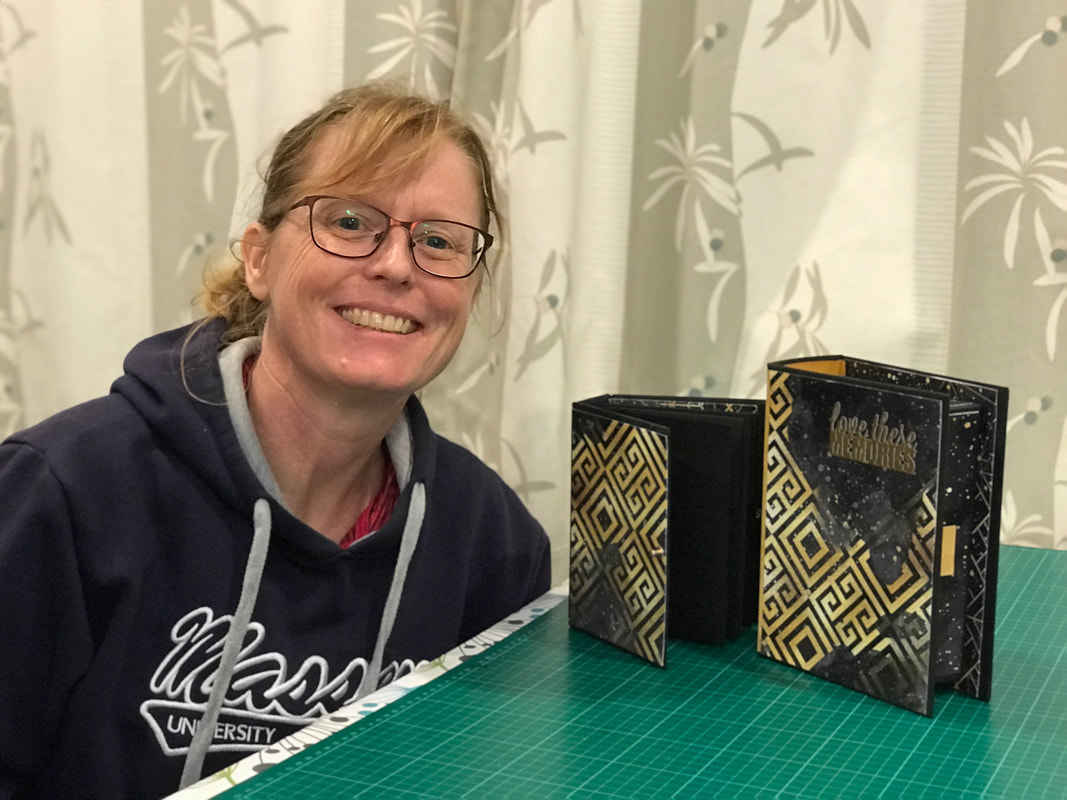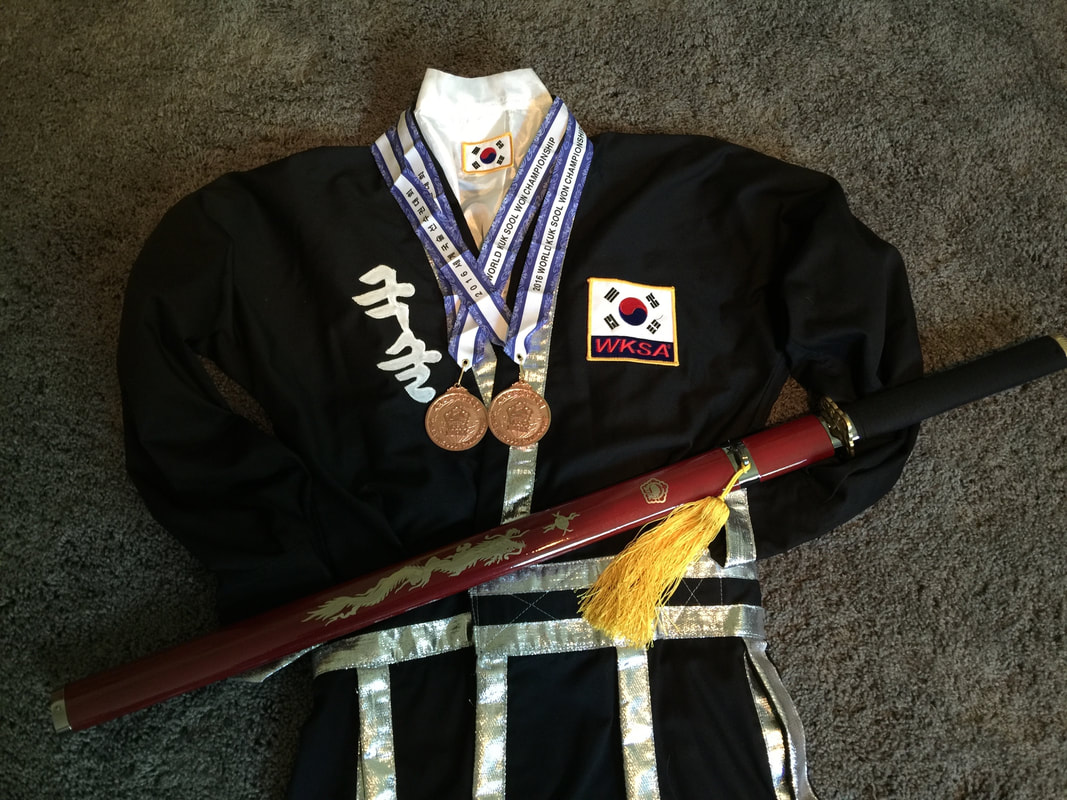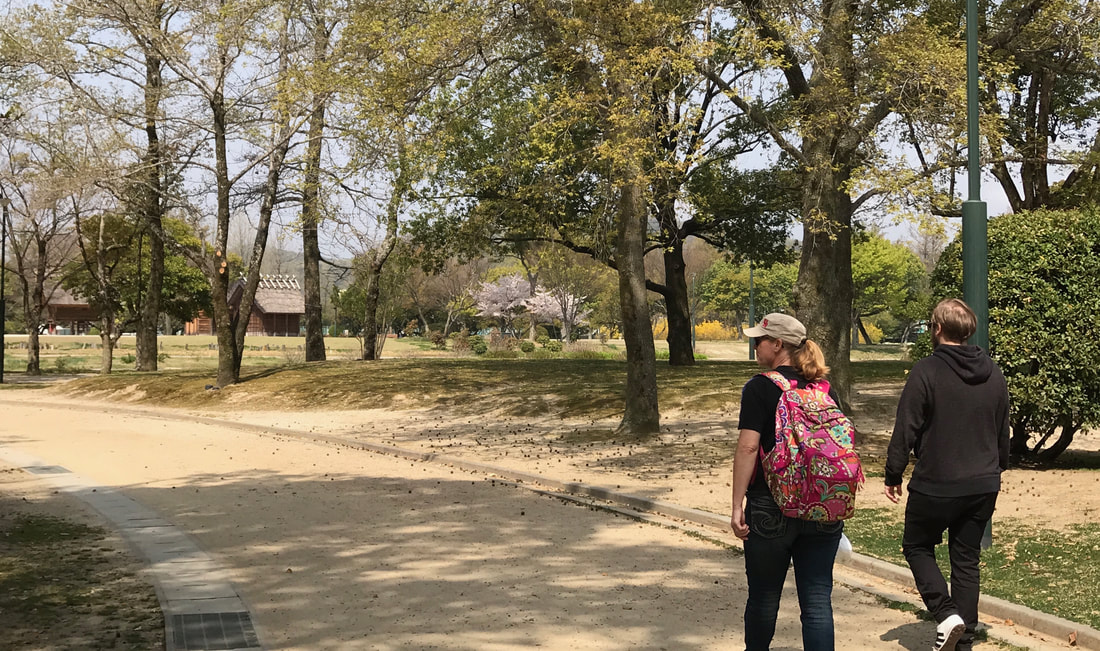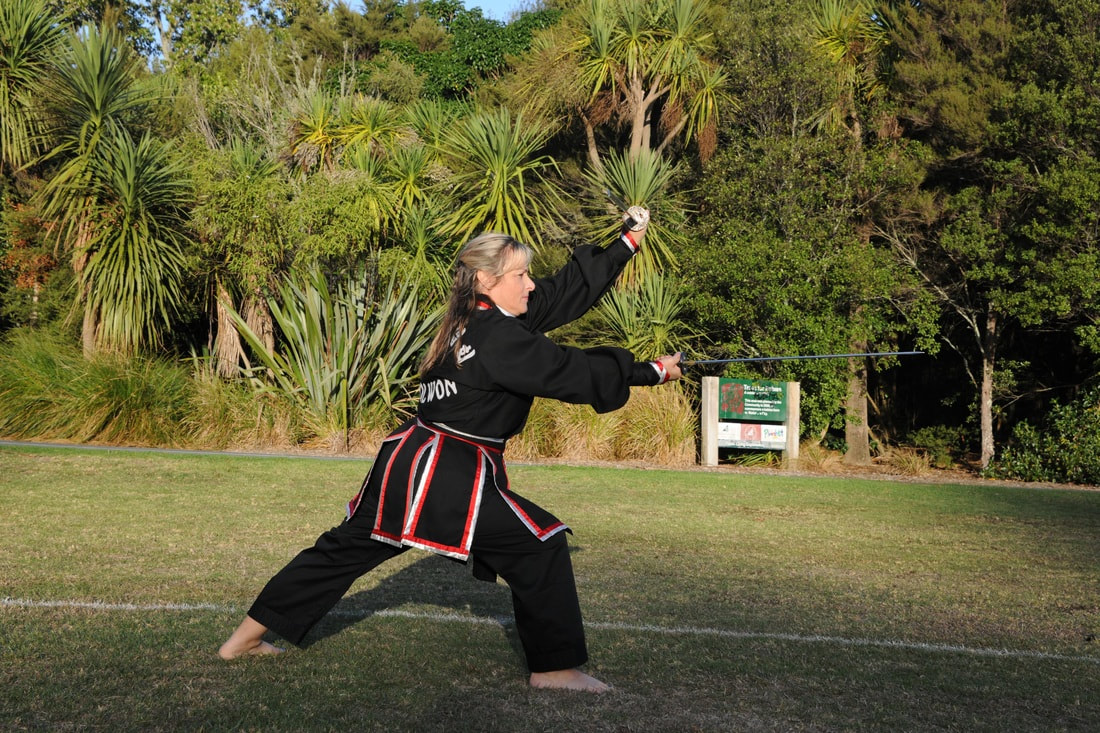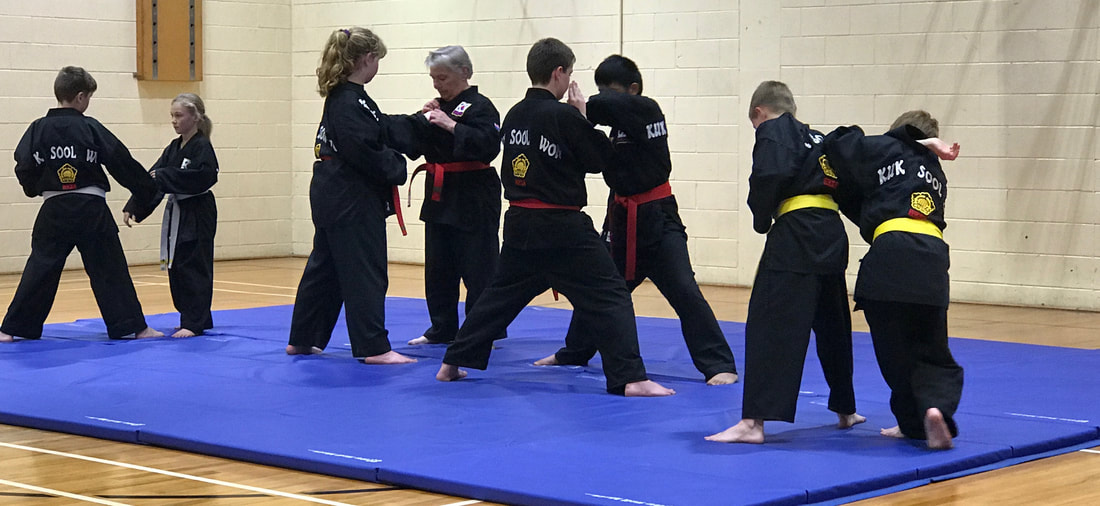|
We have returned to training after our two week winter break. These training breaks give us an important opportunity to rest our bodies and minds, catch up on jobs at home, and spend time with our families and friends. For me, this break has also reminded me about the importance of balance in my life and trying new things.
As a school owner and avid Kuk Sool Won™ martial artist, I am very focused on my teaching and training. It is easy for it to become all consuming. When I am teaching and training I think of nothing else. It is a very mindful experience. At other times, I am working with SBN Caroline on the planning, administration and marketing for our schools. I also spend much of my spare time thinking about my training. I go through my techniques and forms in my head. It is a form of meditation for me and keeps me focused and my memory sharp. During these school holidays, I have devoted quite a bit of time to Kuk Sool admin. However, I also spent a few days at a craft expo. For three days, I participated in several different paper craft workshops. I made four different types of mini-journals using craft papers, cardstock and embellishments. I got my hands dirty with mixed media projects using acrylics and inks. I also made paper, velum and foam flowers. As a novice crafter, I found these workshops intense. I had to learn how to use different types of materials, follow instructions that I often didn’t understand, develop new skills, and cope with making mistakes. While it was often challenging, it was also incredibly rewarding. I not only learnt a lot, I also got to make some really neat journals which I can fill with photos and memories. So why is this crafting experience relevant to my martial arts training? There are three main reasons.
JKN Jane Hurst First degree black belt and school owner Kuk Sool Won™ of Pukekohe and Onewhero Copyright © 2018. Kuk Sool Won™ of Onewhero. All Rights Reserved.
2 Comments
It’s the winter school holidays in New Zealand and we have closed our martial arts school for two weeks. Unlike many schools in other countries, we always take a break from training during the school holidays. It’s good for us and for our students for three important reasons.
Instructors need a break from time to time as well. Teaching is mentally and physically draining. A huge amount of energy is required to keep classes enjoyable and to ensure everyone is learning. Like teachers and university lecturers, martial arts instructors need time away from the dojang to recharge their energy levels. This enables us to teach classes with our full attention and energy, to ensure it is the best experience possible for our students. Taking a short training break does not mean we do nothing. It is important to rest and relax physically and mentally, but it is also equally important to keep our bodies moving. We encourage our students to keep physically active by doing something different and enjoyable. This might involve walking, swimming or cycling for example, as part of a holiday activity. And don’t forget to plan some social time with your family and friends. Enjoy your training holiday. JKN Jane Hurst First degree black belt and school owner Kuk Sool Won™ of Onewhero Copyright © 2018. Kuk Sool Won™ of Onewhero. All Rights Reserved.
In my recent blogs I have been exploring the concept of mindfulness as it relates to the practice of martial arts and personal safety. Mindfulness, in essence, involves fully paying attention to the present moment, without judging or reacting to it. Living mindfully is good for our health and wellbeing. It enables us to gain control over our attention, attitude, and actions. This means we can break the cycle of worry and negative self-talk, focus on and live fully in the present moment, and act in ways that are well thought through and beneficial to us. This makes us feel happier and our life richer and more meaningful.
Mindfulness is not easy to achieve and does not come naturally to most of us. Our minds get flooded with thoughts and judgments, we get distracted, and we often try juggling too many things at once. We rarely completely focus our full awareness on each present moment, without any form of judgment. Mindfulness therefore, is something we need to practice. Mindfulness can be practised at anytime, anywhere, and while undertaking any activity. This includes mindful movement, such as martial arts. Here are five exercises you can use to bring mindfulness into your regular martial arts practice. 1. Mindfully warming up: Observe your body when you are doing your warm up. Really focus your attention and awareness on each part of your body. This includes noticing for example, the sensations in your muscles as you are stretching them. For example, are they tense, relaxed, sore, or tight? Notice your thoughts and gently let go of any judgments, such as, “I am not flexible enough” or “I’m in pain and will really struggle tonight”. If you find your mind drifting off, gently bring it back to observing your body. 2. Observe your breathing: Focus your awareness on the air flowing in and then flowing out. This involves observing the movement of your lungs, chest and belly, the sensations in your nostrils, and the pauses in between the in and out breaths. Observe your breath not only when stationary, but also when you are moving, such as during your kicks, techniques and martial arts forms. Experiment with lengthening your in and out breath. When doing a kihap (kiai or martial arts yell), observe the sensation of the air being forced out of your lungs. 3. Move mindfully: When undertaking a specific martial arts movement, such as a kick, follow the sensations in your body as you move. For example, when doing a roundhouse kick, focus on the sensations in your body when you are in your martial arts stance. Observe each change in movement as you prepare for and execute the kick. Focus on the sensations in your muscles and joints when for example, lift your leg to chamber, you pivot on the ball of your base foot, you extend your leg to kick, and when you return back to your stance. Slow each movement down and really focus on the sensations in your body. 4. Observe your thoughts: When doing a series of martial arts movements, such as hyung or forms in Kuk Sool Won™ (patterns in Taekwondo or kata in karate), we often have a mixture of thoughts in our head. Some of these can be quite negative, such as “I can never remember”, or “I’m never going to be good enough”, or “I can’t get low enough in my stances”. Sometimes we are on autopilot, with no conscious thoughts in our minds or with our thoughts distracted by something else. Even positive thoughts can detract from being fully present in our bodies. To achieve a better balance between our thoughts and movements, we first need to become aware of our thinking. We do this by observing our thoughts, without judging them or trying to control them. This exercise enables us to become aware of how our thoughts intrude on and distract us from fully experiencing each present moment. 5. Participate with awareness: Once we become aware of our thoughts, we can then begin to gently let go of those which are negative or distracting. If we pay full attention to what we are doing in each moment and let go of everything else, we are participating fully in that moment. Once you have practised observing your thoughts, try to do your forms while letting go of all those thoughts and judgments that are distracting or negative. As they come into your head, notice them and then gently let them go rather than fixate on them. Refocus on each movement. While it is not easy, over time it will come more naturally to you. It will add to your ability to improve your form and make your training much more enjoyable. Mindfulness is something which needs to be practised. Try these exercises for several weeks and observe how they affect your training. You can also try finding other ways to incorporate these types of mindfulness skills into your other martial arts activities (such as breakfalls and technique training), and then into other aspects of your daily life. This will not only improve your martial arts training, but also act as a great stress reliever. JKN Jane Hurst First degree black belt and school owner Kuk Sool Won™ of Onewhero Copyright © 2018. Kuk Sool Won™ of Onewhero. All Rights Reserved.
In my last blog I looked at the link between martial arts and mindfulness and how the mindful practice of martial arts has made my life richer and more enjoyable. Practising mindfulness enriches the quality of our lives by reducing stress and anxiety, as well as enabling us to enjoy each present moment. It also serves another very practical and important function. Living more mindfully enhances our personal safety.
Mindfulness is a state of being, where we are completely present and living with full awareness of each moment. By living fully in the present moment, we can give our full attention and focus to our present task or activity, whether it is sitting reading a book, taking a walk, or practising martial arts. When it comes to personal safety, mindfulness enables us to become much more aware of our surroundings. How many times have we walked along a street caught up in our thoughts or looking at our phone, unaware of what is happening around us? Or driven a familiar route on autopilot while we reflect on our day or some problem that is troubling us? Our lack of awareness can expose us to risks, which could be avoided if we practised mindfulness in our daily lives and activities. Here are some mindful ways we can improve our personal safety.
JKN Jane Hurst First degree black belt and school owner Kuk Sool Won™ of Onewhero Copyright © 2018. Kuk Sool Won™ of Onewhero. All Rights Reserved.
When I am practising and teaching my martial art of Kuk Sool Won™, nothing else exists. I am not thinking about what has happened in my day or what I will be doing later. I am freed from any worries that may be causing me stress. My mind is focused on one thing; what I am doing in that moment. For me, martial arts is a mindful practice.
Most people will have heard of mindfulness. It is the big thing at the moment with loads of books published on the subject and a huge array of mindfulness courses available. It has the potential to truly enhance a person’s quality of life if it is understood and practiced correctly. What most people may not realise though, is that a traditional martial art such as Kuk Sool Won™ incorporates and teaches the concepts and benefits of mindfulness. It is a mindful practice. To understand this relationship, we need to understand what mindfulness is and how it is relevant to the practice of martial arts. Mindfulness is derived from eastern Buddhist practices where monks would meditate for hours to still and empty their mind. They saw this as a path to enlightenment, something which takes a lifetime of practice to achieve. Given its Buddhist origins, most people associate mindfulness with the concept of being completely still and of emptying our minds. However, for most of us, this is not realistic. Our lives are too busy, are minds are too filled with thoughts that we struggle to control, and we have little free time to sit and do nothing. Mindfulness as it has been related to westernised culture, is based on the principle of focus rather than on emptying of our minds and as such, it doesn’t require us to meditate or to be completely still for extended periods of time. Instead, mindfulness is a state of being, where we are completely present and living with full awareness of each moment. This frees us from worry about the future or thinking about a multitude of things at once. By living fully in the present moment, we can give our full attention and focus to our present task or activity, whether it is sitting reading a book, taking a walk, or practising martial arts. Being fully present and mindful not only requires us to focus solely on the task at hand, but also to do it in a non-judgmental way. This involves gently letting go of the negative self-talk and the judgments we make about ourselves, such as “I’m not doing this well enough” or “I will never be good enough”. When I first started practising martial arts, I would become distracted by my thoughts and self-judgments. I would reflect on my day during the warm up and think about what I would be having for dinner or doing tomorrow. I would also have a frequent internal dialogue on all of the things I was doing wrong or not good at. I would criticise myself for not being good at kicks, or not remembering my forms, or not getting my techniques right. As I progressed in my training, this began to change and I am now much more mindful in my training and teaching. For example, instead of thinking about my day, I now focus on my body and how it feels during the warm up. This is the time when I connect with and prepare for my training and the class I am teaching. When I am training, I do it with awareness and focus on what I am doing. While I am aware of how well I am performing it, I rarely criticise myself now. Instead, my awareness provides me with important information which I can use to help me improve. I am also not thinking about what I will be doing next. Instead, I am focused on that present moment. There is a connection between my body and mind, in each moment of my training, which makes it a much more enjoyable experience. It reduces my stress rather than adding to it. This flows through to my teaching, enabling me to give my students my full attention and the best teaching experience I can. Martial arts training has taught me how to be fully in the present moment, in a non-judgmental way. While I am not able to replicate this at all times, in all aspects of my life, it does have a flow on effect by encouraging me to be more present and aware, as well as less judgmental throughout my day. My life is richer and more enjoyable as a result. JKN Jane Hurst First degree black belt and school owner Kuk Sool Won™ of Onewhero Copyright © 2018. Kuk Sool Won™ of Onewhero. All Rights Reserved.
Some martial artists believe that in order to really learn to defend yourself, you have to practice full contact fighting. They maintain that it’s an essential part of the physical conditioning needed for self-defense and that by being hit, you learn what it feels like and will be better able to cope with it in a real life fight. I disagree.
There was a time in my past when I was hit hard, on more than one occasion. Fortunately I was never hit in the head so was never knocked unconscious. But I have been hit for real and I know what it feels like. I don’t need to practice full contact fighting to know that at best, being hit hurts like heck and will affect my ability to defend myself. At worst, it may knock me out or even kill me if I am really unlucky. Not long ago, a New Zealand security guard was punched in the head and killed. This shows how deadly just one punch can be. I also know that the last place I want to be is in a stand up fight with anyone, particularly if that person is bigger and stronger than me. As a relatively small woman, that makes up a lot of the population! I might have a number of physical self-defense skills in my toolkit, but all it can take is one good punch to the head and its curtains for me. The true art of self-defense is not learning how to fight. No matter how skilled you are as a martial artist, a real life fight is always going to be unpredictable and there is a real possibility that you will get seriously hurt. Self-defense is about never needing to fight or only using your self-defense skills as an absolute last resort. Self-defense is about being well prepared. What we do in our everyday lives has a major influence on whether we will ever need to physically defend ourselves. True self-defense starts with:
Self-defense is also about physical conditioning. However, we don’t need to practice full contact fighting to condition our bodies. Our martial art of Kuk Sool Won™ physically conditions us in many ways; through the practice of forms, kicks, falling techniques, weapons training, and self-defense techniques. No or minimal contact sparring also conditions the body and improves our speed and reflexes, without the need to be physically hurt. These are all an important part of developing our body and mind to react in the best possible way if we are ever faced with a physical confrontation There may be times when we have no choice but to physically defend ourselves. I hope that situation never arises but if it does, my focus will be on using my martial arts training to get away from the situation as quickly as possible and hopefully, physically and psychologically unharmed. However, using my martial arts skills is the last resort in my self-defense toolkit. I hope I never have to use them. JKN Jane Hurst First degree black belt and school owner Kuk Sool Won™ of Onewhero Copyright © 2018. Kuk Sool Won™ of Onewhero. All Rights Reserved.
Martial arts are challenging and as a result, many people quit within the first few months. In my last blog I focused on some of the challenges new students encounter, based on our experience as instructors and school owners in the traditional Korean martial art of Kuk Sool Won™.
The first few months are exciting for new students, but they can also be daunting. How instructors respond to these challenges can make a big difference to how new students experience their introduction to martial arts. Here are some of the ways we try to make these early stages less overwhelming and more enjoyable for white belts at our Kuk Sool Won™ school.
Starting a martial art can be a little daunting but it is also an exciting time. A white belt in Kuk Sool Won™ learns so much in their first few months and it is incredibly rewarding as an instructor to see their growth and development. It is also our job to make sure we make these first few months as easy and stress free as possible, as they transition into martial arts training. JKN Jane Hurst First degree black belt and school owner Kuk Sool Won™ of Onewhero Copyright © 2018. Kuk Sool Won™ of Onewhero. All Rights Reserved.
Starting a martial art can be a very challenging experience. Depending on the style of martial arts, there can be a lot of material to learn at white belt level and at times, it can feel overwhelming and daunting. You are in a new environment, with people you probably don’t know. You are learning new skills and physically challenging your body in new and demanding ways. Everything is new and you can feel completely out of your comfort zone. I know I certainly did during my first few months as a white belt in Kuk Sool Won™. It was physically very hard for me and I felt outside of my comfort zone by how much there was to learn, particularly about the etiquette surrounding a traditional martial art. Fortunately, I had a very patient instructor who gently helped me through those challenging first few months.
I am now a Kuk Sool Won™ instructor and school owner and I regularly work with our new students. In the collective experience of myself and fellow school owner and 4th degree black belt, SBN Caroline, we have found that our new Kuk Sool students tend struggle with some or all of the following elements.
While it is not possible to remove these challenges, there are ways to make the first few months easier for new students and in my next blog I will focus on these. The key message for new students though, is this. It is completely normal to feel outside of your comfort zone when you first start. Your fellow students and instructors have all been there and experienced it. We understand and want to support you through the challenging first few months. Stick at it as the rewards of martial arts training are definitely worth it. JKN Jane Hurst First degree black belt and school owner Kuk Sool Won™ of Onewhero Copyright © 2018. Kuk Sool Won™ of Onewhero. All Rights Reserved.
We have recently had a few new people join our martial arts school (Kuk Sool Won™ of Pukekohe and Onewhero). This has given me the opportunity to reflect on the many benefits white belts bring to our school, as well as the challenges and issues they face when they start their training. In this first blog in a series relating to white belts, I will look at why new students are great for a martial arts school.
We really value our new students and it’s not for the reason you make think. Sure they bring in some more income for us, which helps with the costs of running a martial arts school. But our white belts bring much more to our school than money.
For those of you who have recently started a martial art and feel that you are “just a white belt”, I urge you to wear your white belt with pride. You are a fundamental part of your martial arts school and bring so many important benefits to your fellow students and instructors. JKN Jane Hurst First degree black belt and school owner Kuk Sool Won™ of Onewhero Copyright © 2018. Kuk Sool Won™ of Onewhero. All Rights Reserved.
In our experience and as discussed in my last blog on perseverance, the majority of people who quit martial arts training do so at two key points; within the first few months and shortly after becoming a black belt. There are many reasons people quit. The novelty of training may have worn off and they may be struggling with the commitment required to progress. They may have become frustrated with themselves and believe they are not good enough. Or they may be struggling with injury or illness. For newly promoted black belts, they may feel that they have achieved their goal and don’t want to make the commitment to several more years of training to progress to the next level.
There are a myriad of reasons for quitting. However, the way people quit is similar. They will often tell their instructor by text or email after they have made the decision to leave. Some just stop training without even telling their instructor. Others will say they are taking a break, but in our experience few will ever return to training. While students may quit in different ways and for differing reasons, one thing is consistent. They rarely talk to their instructor about the difficulties they are experiencing before they make the decision to quit. At some point during your martial art career you are likely to feel like giving up. So what should you do if you feeling like quitting?
Martial arts training is not easy. It is difficult and you are likely to feel like quitting at times. I am interested to hear about your experiences. Have you ever felt like quitting and if so, what did you do about it? Please leave a comment. JKN Jane Hurst First degree black belt and school owner Kuk Sool Won™ of Onewhero Copyright © 2018. Kuk Sool Won™ of Onewhero. All Rights Reserved. |
Caroline and Jane Hurst
Caroline is a 5th degree black belt and Jane is a 2nd degree black belt in the traditional Korean martial art of Kuk Sool Won™ . They run 2 Kuk Sool Won™ martial arts schools in New Zealand. Archives
March 2019
Categories
All
|

